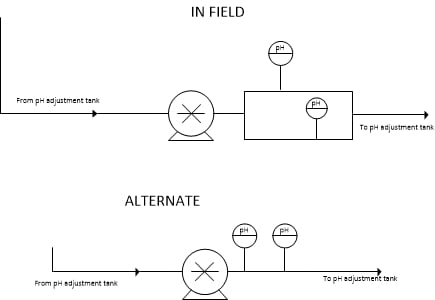jari001
Chemical
- Aug 9, 2013
- 478
Hi everyone,
I'm looking at a 100 gallon tank wastewater tank (acidic but no solids) that is continuously re-circ'd through a 1" OD PVC pipe and pH adjusted before discharging to the sewer. The pH adjustment is controlled by operators via the DCS (dose in NaOH as needed) and there is an interlock that prevents discharge unless both pH sensors are reading the same pH (within some tolerance). The acceptable range is 6 to 8. My question is regarding the shown layout for how the sensors are installed; does the branching afford any advantage in measurement performance or some other advantage? My only thought is that you can isolate one line at a time so you don't have to lose re-circ if you have to replace a sensor.

I'm looking at a 100 gallon tank wastewater tank (acidic but no solids) that is continuously re-circ'd through a 1" OD PVC pipe and pH adjusted before discharging to the sewer. The pH adjustment is controlled by operators via the DCS (dose in NaOH as needed) and there is an interlock that prevents discharge unless both pH sensors are reading the same pH (within some tolerance). The acceptable range is 6 to 8. My question is regarding the shown layout for how the sensors are installed; does the branching afford any advantage in measurement performance or some other advantage? My only thought is that you can isolate one line at a time so you don't have to lose re-circ if you have to replace a sensor.


![[sadeyes] [sadeyes] [sadeyes]](/data/assets/smilies/sadeyes.gif)